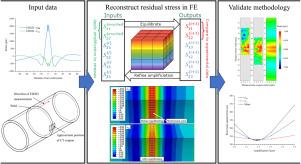Residual stress reconstruction by amplification of limited measurement data via finite element analysis
IF 9.4
1区 工程技术
Q1 ENGINEERING, MECHANICAL
International Journal of Mechanical Sciences
Pub Date : 2024-11-03
DOI:10.1016/j.ijmecsci.2024.109803
引用次数: 0
Abstract
Welded components contain complex residual stress fields which are important to quantify when assessing their structural integrity. Often such assessments involve finite element simulation of the components; thus it is essential to include residual stress fields in the model. While previous methods have been proposed to include residual stresses in finite element models (e.g. using iterative methods or eigenstrain reconstruction of residual stresses), these can be theoretically cumbersome and computationally expensive. In this work a novel technique for reconstruction of residual stresses in welds is presented, based on iterative stress imposition and relaxation, and using limited residual stress data from energy dispersive X-ray diffraction (EDXD) measurements. This method is validated using a combination of neutron imaging of small sections of the weld and finite element analysis. A root mean squared (RMS) error of 127.26 was achieved between the FE model and the EDXD measurement. Although the method is only viable for relatively simple geometries such as pipes and plates, this covers the most likely use cases in relevant industries such as nuclear energy. Reconstruction of residual stress fields can assist structural integrity assessments by requiring less measured residual stress data. As well as reducing measurement costs our method may enable less overly-conservative assessments, particularly for flaws that do not lie on a weld centreline. This work also demonstrates that neutron imaging residual strain measurement is a valuable tool for validating methods of weld residual stress modelling.

通过有限元分析放大有限测量数据重建残余应力
焊接部件包含复杂的残余应力场,在评估其结构完整性时必须对其进行量化。此类评估通常涉及部件的有限元模拟,因此必须将残余应力场纳入模型中。虽然之前已经提出了将残余应力纳入有限元模型的方法(例如使用迭代法或残余应力的特征应变重建),但这些方法在理论上可能比较繁琐,计算成本也很高。在这项工作中,提出了一种基于迭代应力施加和松弛,并利用能量色散 X 射线衍射(EDXD)测量得到的有限残余应力数据,重建焊缝残余应力的新技术。该方法结合焊缝小截面的中子成像和有限元分析进行验证。有限元模型和 EDXD 测量之间的均方根误差为 127.26 μɛ。虽然该方法仅适用于管道和板材等相对简单的几何形状,但它涵盖了核能等相关行业最可能的使用案例。残余应力场的重建可以减少残余应力数据的测量,从而有助于结构完整性评估。除了降低测量成本外,我们的方法还能减少过于保守的评估,尤其是针对不在焊接中心线上的缺陷。这项工作还表明,中子成像残余应变测量是验证焊接残余应力建模方法的重要工具。
本文章由计算机程序翻译,如有差异,请以英文原文为准。
求助全文
约1分钟内获得全文
求助全文
来源期刊

International Journal of Mechanical Sciences
工程技术-工程:机械
CiteScore
12.80
自引率
17.80%
发文量
769
审稿时长
19 days
期刊介绍:
The International Journal of Mechanical Sciences (IJMS) serves as a global platform for the publication and dissemination of original research that contributes to a deeper scientific understanding of the fundamental disciplines within mechanical, civil, and material engineering.
The primary focus of IJMS is to showcase innovative and ground-breaking work that utilizes analytical and computational modeling techniques, such as Finite Element Method (FEM), Boundary Element Method (BEM), and mesh-free methods, among others. These modeling methods are applied to diverse fields including rigid-body mechanics (e.g., dynamics, vibration, stability), structural mechanics, metal forming, advanced materials (e.g., metals, composites, cellular, smart) behavior and applications, impact mechanics, strain localization, and other nonlinear effects (e.g., large deflections, plasticity, fracture).
Additionally, IJMS covers the realms of fluid mechanics (both external and internal flows), tribology, thermodynamics, and materials processing. These subjects collectively form the core of the journal's content.
In summary, IJMS provides a prestigious platform for researchers to present their original contributions, shedding light on analytical and computational modeling methods in various areas of mechanical engineering, as well as exploring the behavior and application of advanced materials, fluid mechanics, thermodynamics, and materials processing.
 求助内容:
求助内容: 应助结果提醒方式:
应助结果提醒方式:


